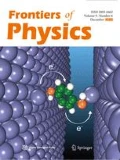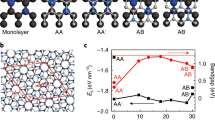Abstract
The two-dimensional (2D) C3N has emerged as a material with promising applications in high performance device owing to its intrinsic bandgap and tunable electronic properties. Although there are several reports about the bandgap tuning of C3N via stacking or forming nanoribbon, bandgap modulation of bilayer C3N nanoribbons (C3NNRs) with various edge structures is still far from well understood. Here, based on extensive first-principles calculations, we demonstrated the effective bandgap engineering of C3N by cutting it into hydrogen passivated C3NNRs and stacking them into bilayer het-erostructures. It was found that armchair (AC) C3NNRs with three types of edge structures are all semiconductors, while only zigzag (ZZ) C3NNRs with edges composed of both C and N atoms (ZZ-CN/CN) are semiconductors. The bandgaps of all semiconducting C3NNRs are larger than that of C3N nanosheet. More interestingly, AC-C3NNRs with CN/CN edges (AC-CN/CN) possess direct bandgap while ZZ-CN/CN have indirect bandgap. Compared with the monolayer C3NNR, the bandgaps of bilayer C3NNRs can be greatly modulated via different stacking orders and edge structures, varying from 0.43 eV for ZZ-CN/CN with AB’-stacking to 0.04 eV for AC-CN/CN with AA-stacking. Particularly, transition from direct to indirect bandgap was observed in the bilayer AC-CN/CN heterostructure with AA’-stacking, and the indirect-to-direct transition was found in the bilayer ZZ-CN/CN with AB-stacking. This work provides insights into the effective bandgap engineering of C3N and offers a new opportunity for its applications in nano-electronics and optoelectronic devices.
Similar content being viewed by others
References
A. H. Castro Neto, F. Guinea, N. M. R. Peres, K. S. Novoselov, and A. K. Geim, The electronic properties of graphene, Rev. Mod. Phys. 81(1), 109 (2009)
S. Z. Butler, S. M. Hollen, L. Cao, Y. Cui, J. A. Gupta, H. R. Gutiérrez, T. F. Heinz, S. S. Hong, J. Huang, A. F. Ismach, E. Johnston-Halperin, M. Kuno, V. V. Plashnitsa, R. D. Robinson, R. S. Ruoff, S. Salahuddin, J. Shan, L. Shi, M. G. Spencer, M. Terrones, W. Windl, and J. E. Goldberger, Progress, challenges, and opportunities in two-dimensional materials beyond graphene, ACS Nano 7(4), 2898 (2013)
K. S. Novoselov, A. Mishchenko, A. Carvalho, and A. H. Castro Neto, 2D materials and van der Waals heterostructures, Science 353(6298), aac9439 (2016)
A. A. Balandin, S. Ghosh, W. Bao, I. Calizo, D. Teweldebrhan, F. Miao, and C. N. Lau, Superior thermal conductivity of single-layer graphene, Nano Lett. 8(3), 902 (2008)
C. Lee, X. Wei, J. W. Kysar, and J. Hone, Measurement of the elastic properties and intrinsic strength of monolayer graphene, Science 321(5887), 385 (2008)
A. K. Geim and K. S. Novoselov, The rise of graphene, Nat. Mater. 6(3), 183 (2007)
I. Meric, M. Y. Han, A. F. Young, B. Ozyilmaz, P. Kim, and K. L. Shepard, Current saturation in zero-bandgap, top-gated graphene field-effect transistors, Nat. Mater. 3, 654 (2008)
F. Schwierz, Graphene transistors, Nat. Nanotechnol. 5(7), 487 (2010)
S. Yang, L. Zhi, K. Tang, X. Feng, J. Maier, and K. Müllen, Efficient synthesis of heteroatom (N or S)-doped graphene based on ultrathin graphene oxide-porous silica sheets for oxygen reduction reactions, Adv. Funct. Mater. 22(17), 3634 (2012)
J. Mahmood, E. K. Lee, M. Jung, D. Shin, H. J. Choi, J. M. Seo, S. M. Jung, D. Kim, F. Li, M. S. Lah, N. Park, H. J. Shin, J. H. Oh, and J. B. Baek, Two-dimensional polyaniline (C3N) from carbonized organic single crystals in solid state, Proc. Natl. Acad. Sci. USA 113(27), 7414 (2016)
S. Yang, W. Li, C. Ye, G. Wang, H. Tian, C. Zhu, P. He, G. Ding, X. Xie, Y. Liu, Y. Lifshitz, S.T. Lee, Z. Kang, and M. Jiang, C3N-A 2D crystalline, hole-free, tunable-narrow-bandgap semiconductor with ferromagnetic properties, Adv. Mater. 29(16), 1605625 (2017)
K. Kim, J. Y. Choi, T. Kim, S. H. Cho, and H. J. Chung, A role for graphene in silicon-based semiconductor devices, Nature 479(7373), 338 (2011)
B. Mortazavi, Ultra high stiffness and thermal conductivity of graphene like C3N, Carbon 118, 25 (2017)
X. Wang, Q. Li, H. Wang, Y. Gao, J. Hou, and J. Shao, Anisotropic carrier mobility in single- and bi-layer C3N sheets, Physica B 537, 314 (2018)
X. Zhou, W. Feng, S. Guan, B. Fu, W. Su, and Y. Yao, Computational characterization of monolayer C3N: A two-dimensional nitrogen-graphene crystal, J. Mater. Res. 32(15), 2993 (2017)
X. Peng, Q. Wei, and A. Copple, Strain-engineered direct-indirect band gap transition and its mechanism in two-dimensional phosphorene, Phys. Rev. B 90(8), 085402 (2014)
H. Rostami, A. G. Moghaddam, and R. Asgari, Effective lattice Hamiltonian for monolayer MoS2: Tailoring electronic structure with perpendicular electric and magnetic fields, Phys. Rev. B 88(8), 085440 (2013)
Y. W. Son, M. L. Cohen, and S. G. Louie, Energy gaps in graphene nanoribbons, Phys. Rev. Lett. 97(21), 216803 (2006)
C. Ataca, H. Şahin, E. Aktürk, and S. Ciraci, Mechanical and electronic properties of MoS2 nanoribbons and their defects, J. Phys. Chem. C 115(10), 3934 (2011)
K. Dolui, C. D. Pemmaraju, and S. Sanvito, Electric field effects on armchair MoS2 nanoribbons, ACS Nano 6(6), 4823 (2012)
Q. Li, H. Wang, H. Pan, and Y. Ding, Tunable electronic structures and magnetic properties of zigzag C3N nanoribbons, J. Phys. D Appl. Phys. 51(34), 345301 (2018)
M. B. Tagani and S. I. Vishkayi, Polyaniline (C3N) nanoribbons: Magnetic metal, semiconductor, and half-metal, J. Appl. Phys. 124(8), 084304 (2018)
J. Dai and X. C. Zeng, Bilayer phosphorene: Effect of stacking order on bandgap and its potential applications in thin-film solar cells, J. Phys. Chem. Lett. 5(7), 1289 (2014)
J. E. Padilha, A. Fazzio, and A. J. da Silva, Van der Waals heterostructure of phosphorene and graphene: Tuning the Schottky barrier and doping by electrostatic gating, Phys. Rev. Lett. 114(6), 066803 (2015)
A. Bafekry, C. Stampfl, and S. Farjami Shayesteh, A first-principles study of C3N nanostructures: Control and engineering of the electronic and magnetic properties of nanosheets, tubes and ribbons, ChemPhysChem 21(2), 164 (2020)
Y. Ding and Y. Wang, Stable H-terminated edges, variable semiconducting properties, and solar cell applications of C3N nanoribbons: A first-principles study, ACS Omega 3(8), 8777 (2018)
M. Dürr and U. Höfer, Molecular beam investigation of hydrogen dissociation on Si(001) and Si(111) surfaces, J. Chem. Phys. 121(16), 8058 (2004)
J. Shi, H. C. Kang, E. S. Tok, and J. Zhang, Evidence for hydrogen desorption through both interdimer and in-tradimer paths from Si(100)−(2×1), J. Chem. Phys. 123, 34701 (2005)
G. Kresse and J. Furthmuller, Efficiency of ab-initio total energy calculations for metals and semiconductors using a plane-wave basis set, Comput. Mater. Sci. 6(1), 15 (1996)
J. P. Perdew, K. Burke, and M. Ernzerhof, Erratum: Generalized gradient approximation made simple (Phys. Rev. Lett. (1996) 77 (3865)), Phys. Rev. Lett. 78, 1396 (1997)
A. V. Krukau, O. A. Vydrov, A. F. Izmaylov, and G. E. Scuseria, Influence of the exchange screening parameter on the performance of screened hybrid functionals, J. Chem. Phys. 125(22), 224106 (2006)
P. Ágoston, K. Albe, R. M. Nieminen, and M. J. Puska, Intrinsic n-type behavior in transparent conducting oxides: A comparative hybrid-functional study of In2O3, SnO2, and ZnO, Phys. Rev. Lett. 103(24), 245501 (2009)
F. Oba, M. Choi, A. Togo, and I. Tanaka, Point defects in ZnO: An approach from first principles, Sci. Technol. Adv. Mater. 12(3), 034302 (2011)
J. Kang, W. Liu, D. Sarkar, D. Jena, and K. Banerjee, Computational study of metal contacts to monolayer transition-metal dichalcogenide semiconductors, Phys. Rev. X 4(3), 031005 (2014)
L. Liu, D. A. Siegel, W. Chen, P. Liu, J. Guo, G. Duscher, C. Zhao, H. Wang, W. Wang, X. Bai, K. F. McCarty, Z. Zhang, and G. Gu, Unusual role of epilayer — substrate interactions in determining orientational relations in van der Waals epitaxy, Proc. Natl. Acad. Sci. USA 111(47), 16670 (2014)
Y. Gao, S. Kim, S. Zhou, H.C. Chiu, D. Nélias, C. Berger, W. de Heer, L. Polloni, R. Sordan, A. Bongiorno, and E. Riedo, Elastic coupling between layers in two-dimensional materials, Nat. Mater. 14(7), 714 (2015)
T. Wassmann, A. P. Seitsonen, A. M. Saitta, M. Lazzeri, and F. Mauri, Structure, stability, edge states, and aromaticity of graphene ribbons, Phys. Rev. Lett. 101(9), 096402 (2008)
A. P. Seitsonen, A. M. Saitta, T. Wassmann, M. Lazzeri, and F. Mauri, Structure and stability of graphene nanoribbons in oxygen, carbon dioxide, water, and ammonia, Phys. Rev. B 82(11), 115425 (2010)
M. S. Choi, G. H. Lee, Y. J. Yu, D. Y. Lee, S. Hwan Lee, P. Kim, J. Hone, and W. Jong Yoo, Controlled charge trapping by molybdenum disulphide and graphene in ul-trathin heterostructured memory devices, Nat. Commun. 4(1), 1624 (2013)
Y. C. Lin, R. K. Ghosh, R. Addou, N. Lu, S. M. Eichfeld, H. Zhu, M. Y. Li, X. Peng, M. J. Kim, L. J. Li, R. M. Wallace, S. Datta, and J. A. Robinson, Atomically thin resonant tunnel diodes built from synthetic van der Waals heterostructures, Nat. Commun. 6(1), 7311 (2015)
M. Birowska, K. Milowska, and J. A. Majewski, Van der Waals density functionals for graphene layers and graphite, Acta Phys. Pol. A 120(5), 845 (2011)
Author information
Authors and Affiliations
Corresponding author
Rights and permissions
About this article
Cite this article
Liu, J., Liao, X., Liang, J. et al. Tuning the electronic properties of hydrogen passivated C3N nanoribbons through van der Waals stacking. Front. Phys. 15, 63503 (2020). https://doi.org/10.1007/s11467-020-0982-4
Received:
Accepted:
Published:
DOI: https://doi.org/10.1007/s11467-020-0982-4




